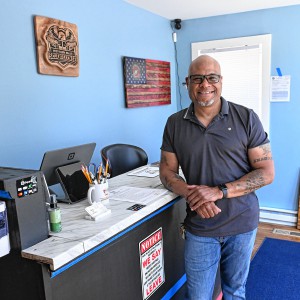Greenfield’s John W. Olver Transit Center wins national sustainability award
| Published: 05-09-2023 4:49 PM |
GREENFIELD — With its solar array, and brick facades designed for seasonal sun angles and usage of natural light, the county’s regional transit center, the first net-zero building of its kind in the United States, has been honored with a national sustainability award.
The John W. Olver Transit Center was awarded the American Institute of Architects’ 2023 Committee on the Environment (COTE) Top Ten award, which is given to 10 projects around the U.S. that take the lead in “setting the standard in design and sustainability.” Officially opened in May 2012, the 24,000-square-foot building is named after former U.S. Rep. John Olver, who died in February at the age of 86, and houses the Franklin Regional Council of Governments (FRCOG) and the Franklin Regional Transit Authority (FRTA) offices.
Charles Rose Architects, a Somerville-based firm, designed the 12 Olive St. building, which was its first net-zero project. Other award winners alongside the John W. Olver Center are Harvard University’s Science and Engineering Complex; San Antonio, Texas’ Confluence Park; and the University of California San Diego’s North Torrey Pines Living and Learning Neighborhood.
“I think it’s a great award because it’s not just a beauty contest, it’s coupled with more data-driven, scientific analysis of the building and how successful it is in actually being a net-zero building,” said Charles Rose, founder of the architecture firm. “It’s an important award because it is demanding technically, and it once again thinks of architecture as an art and a science.”
The building was constructed with dark, American-made brick; copper; and locally sourced stone to help it better fit into Greenfield’s downtown character, while ensuring the building is durable and requires little maintenance. Additionally, the brick facade on the building’s western side is specifically designed to screen the sun’s heat in the summer, while allowing winter afternoon sunlight, which is lower in the sky, to make its way into the building.
Rose said the “transformation of the site was terrific,” as the transit center was built on a brownfield — a property that contains or may contain hazardous materials — and former car dealership. In constructing the building, he noted that the architecture firm’s focus was on adding a green space to the city that can support local species.
Linda Dunlavy, FRCOG’s executive director, said it’s easy for her and her staff to forget they work in such an “awesome building” when they work there on a day-to-say basis.
“Both the COG and the FRTA really work hard to think about the future to think innovative, to think creatively,” Dunlavy said. “The fact that where we work and the building we helped create has now won this national award that speaks to climate resiliency and renewable energy is really a nice physical manifestation of what our work tries to do.”
Article continues after...
Yesterday's Most Read Articles
 My Turn: Quabbin region will never see any benefits from reservoir
My Turn: Quabbin region will never see any benefits from reservoir
 As I See It: Between Israel and Palestine: Which side should we be on, and why?
As I See It: Between Israel and Palestine: Which side should we be on, and why?
 New USDA offices in Greenfield to aid staffing increase, program expansion
New USDA offices in Greenfield to aid staffing increase, program expansion
 Longtime Orange public servant Richard Sheridan dies at 78
Longtime Orange public servant Richard Sheridan dies at 78
 Retired police officer, veteran opens firearms training academy in Millers Falls
Retired police officer, veteran opens firearms training academy in Millers Falls
 Four Rivers boys knock off Xaverian to win Four Rivers Ultimate Tournament on Saturday (PHOTOS)
Four Rivers boys knock off Xaverian to win Four Rivers Ultimate Tournament on Saturday (PHOTOS)
Rose also said the transit center’s low, long size fits into Bank Row’s character, as the building doesn’t tower over the others on the street.
On top of working with the two agencies that are based in the building, the project was also a community effort as public hearings were held to collect resident feedback. The state and federal governments, such as the Department of Energy Resources, were also involved due to grant funding.
“Everything was right on this job. … It was a pleasure to work with everybody,” Rose said. “I’m proud of the way it functions and I love the building aesthetically.”
“It was not an easy project as it was being built. … There were lots of requirements that were hard to comply with because it used the stimulus funding,” Dunlavy added, referring to the American Recovery and Reinvestment Act of 2009. “It’s been a good home for us.”
More in-depth information about the John W. Olver Transit Center’s sustainable design can be found on its award page on the American Institute of Architects’ website at bit.ly/42vtl9g.
Chris Larabee can be reached at clarabee@recorder.com or 413-930-4081.

 Heath native’s bill honoring fallen heroes introduced in Congress
Heath native’s bill honoring fallen heroes introduced in Congress Greenfield Notebook: May 9, 2024
Greenfield Notebook: May 9, 2024 Heath voters OK $1.6M town budget, school spending
Heath voters OK $1.6M town budget, school spending 
